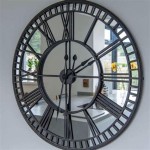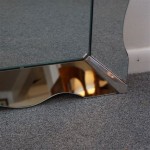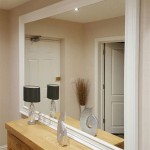Best Way to Hang a Heavy Mirror on a Wall
Hanging a heavy mirror presents unique challenges compared to lighter wall decor. The weight necessitates a secure and reliable hanging method to prevent damage to the mirror, the wall, and, most importantly, potential injury. Selecting the right hardware and using proper installation techniques are crucial for a successful and safe outcome. This article details the most effective methods for hanging heavy mirrors on various wall types, emphasizing the importance of weight assessment, anchor selection, and precise execution.
Before initiating the hanging process, a thorough assessment of the mirror's weight and the wall's composition is paramount. This information dictates the type of mounting hardware required and the appropriate installation strategy. Ignoring these initial steps can lead to inadequate support, resulting in the mirror falling and causing significant damage.
The weight of the mirror should be precisely determined. Most mirrors have a weight specification included in the product information or on the packaging. If this information is unavailable, a bathroom scale can be used. Weighing the mirror while standing on the scale and then subtracting your own weight provides an accurate mirror weight. This value is essential for selecting appropriate anchors and hanging mechanisms.
Identifying the wall type is equally critical. Common wall types include drywall, plaster, wood studs, and masonry (brick or concrete). Each material has different load-bearing capabilities and requires specific types of anchors for secure attachment. Attempting to use drywall anchors on a brick wall, for example, will inevitably result in failure.
Drywall is a common wall material but offers limited structural support. Plaster walls, while often more durable than drywall, can still be fragile and prone to crumbling. Wood studs provide solid anchoring points, and locating them is often the preferred method for hanging heavy items. Masonry walls, depending on their composition and thickness, offer the most robust support but require specialized drilling and anchoring techniques.
Selecting the Appropriate Anchors and Hardware
The choice of anchors and hardware directly impacts the safety and stability of the hanging mirror. The weight of the mirror, combined with the wall type, dictates the appropriate selection. Using undersized or incompatible hardware can compromise the integrity of the installation and lead to a hazardous situation.
For drywall, several types of anchors are available, each with varying weight capacities. Plastic drywall anchors are suitable for very lightweight mirrors (under 5 pounds). Self-drilling drywall anchors, often made of metal or heavy-duty plastic, can support slightly heavier mirrors (up to 10-20 pounds, depending on the specific product). Toggle bolts are the most reliable drywall anchor for heavy mirrors (20 pounds and up). They consist of a bolt and a spring-loaded toggle wing that expands behind the drywall, providing a secure hold.
When hanging a mirror on a plaster wall, it is essential to avoid cracking or damaging the plaster. Pre-drilling pilot holes is often necessary, and the chosen anchor should be suitable for both plaster and the underlying material (drywall or wood lath). Toggle bolts are a good option for plaster walls, as they distribute the weight across a larger area. Another option is using plaster washers, which help to prevent the anchor from pulling through the plaster.
Locating and utilizing wood studs is the most secure method for hanging heavy mirrors. Stud finders can be electronic or magnetic, and they help identify the location of the studs behind the wall. Once a stud is located, screws can be driven directly into the wood, providing a solid and reliable anchor point. Using screws that are long enough to penetrate at least 1.5 inches into the stud is recommended.
Masonry walls require specialized anchors and drilling techniques. Concrete screws, sleeve anchors, and wedge anchors are common choices, depending on the weight of the mirror and the type of masonry. A hammer drill is necessary to create holes in the masonry, and the anchors must be properly sized to fit the holes. Ensuring the anchors are firmly seated and can bear the mirror's weight is crucial for a safe installation.
In addition to anchors, the hanging hardware on the mirror itself must be strong enough to support the weight. D-rings, wire, and other hanging mechanisms should be rated for the mirror's weight. Replacing flimsy or inadequate hardware with more robust alternatives is essential for preventing failure at the mirror itself.
Step-by-Step Installation Process
The installation process involves careful measurement, precise drilling (if necessary), and secure attachment of the mirror to the wall. Accuracy and attention to detail are critical throughout the process to ensure a level and stable installation. Rushing or skipping steps can compromise the integrity of the hanging system and lead to potential problems.
Begin by marking the desired location for the mirror on the wall. Use a level to ensure the mark is straight and accurate. If using wood studs, locate and mark their positions using a stud finder. For drywall or plaster, determine the type of anchor to be used and mark the anchor points according to the anchor manufacturer's instructions.
If drilling is required, use the appropriate drill bit size for the chosen anchors. Drilling pilot holes before inserting screws or anchors can help prevent splitting or cracking of the wall material. When drilling into masonry, use a hammer drill and wear appropriate safety gear, such as eye protection and a dust mask.
Install the anchors according to the manufacturer's instructions. Ensure they are firmly seated and can bear the weight of the mirror. For toggle bolts, carefully thread the bolt through the mirror's hanging hardware and then through the wall. Once the toggle wing is behind the wall, tighten the bolt to secure the mirror in place.
When hanging a mirror using wire, ensure the wire is properly secured to the D-rings on the back of the mirror. The wire should be taut but not overly stretched. If using multiple anchors, distribute the weight evenly across them to prevent overloading any single anchor point.
Once the mirror is hung, double-check its stability. Gently tug on the mirror to ensure it is securely attached to the wall. If there is any movement or instability, re-evaluate the anchors and hardware and make any necessary adjustments. Using a level to confirm the mirror is perfectly straight is essential for a professional and aesthetically pleasing result.
For extremely heavy mirrors, consider using multiple anchors or a French cleat system. A French cleat consists of two interlocking pieces of wood, one attached to the wall and the other to the back of the mirror. This system distributes the weight evenly and provides a very strong and secure hanging method. It's essential to ensure the cleat is securely attached to the wall using appropriate anchors.
Safety Considerations
Safety should be the top priority throughout the entire hanging process. Heavy mirrors can be dangerous if not handled and installed properly. Taking precautions to prevent accidents and injuries is essential for a successful and safe outcome.
Always wear appropriate safety gear, such as gloves and eye protection, when handling and installing heavy mirrors. Gloves can protect your hands from cuts and scrapes, while eye protection can prevent debris from entering your eyes during drilling.
Obtain assistance when handling heavy mirrors. Attempting to lift and hang a heavy mirror alone can lead to strains, sprains, or even more serious injuries. Having a second person to help support and position the mirror can significantly reduce the risk of accidents.
Before drilling into walls, check for any hidden wiring or plumbing. Using a stud finder with a built-in wire detector can help identify the location of electrical wires. If there is any doubt, consult with a qualified electrician or plumber before drilling.
If the wall appears to be damaged or structurally unsound, do not attempt to hang a heavy mirror. Consult with a structural engineer or contractor to assess the wall's integrity and make any necessary repairs before proceeding with the installation.
Regularly inspect the hanging hardware and anchors to ensure they are still in good condition. Over time, anchors can loosen, and hardware can corrode. If any signs of wear or damage are detected, replace the affected components immediately.
By carefully considering the weight of the mirror, selecting the appropriate anchors and hardware, following a precise installation process, and prioritizing safety, ensures the secure and stable hanging of a heavy mirror, preventing damage and potential injury.

How To Hang A Large Or Heavy Mirror

A Better Way To Hang Heavy Mirror Hanging Pictures On The Wall

How To Hang A Heavy Mirror With Pictures Wikihow
How To Hang A 100 Pound Mirror On Drywall Quora

How To Hang A Heavy Mirror Lowe S

How To Hang A Heavy Mirror C R F T

How To Hang A Very Heavy Picture Or Mirror The Best

How To Hang A Heavy Mirror The Home Depot
:strip_icc()/277322633_285355166951460_7559379883177036981_n-ce6011b9b6a54bd18aa6849e62c05f4f.jpg?strip=all)
4 Easy Ways To Hang A Heavy Mirror

How To Hang A Heavy Mirror Or Picture She Holds Dearly








